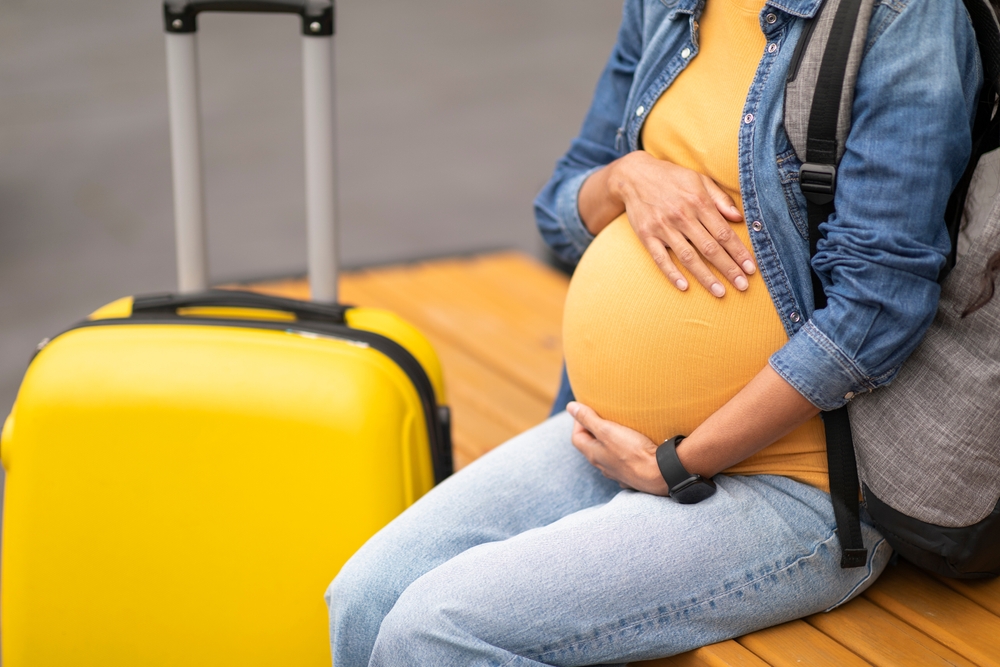With the proper precautions, flying during the first trimester of pregnancy is safe. Here’s what you should know about air travel during early pregnancy.
If you’re currently pregnant, planning to be, or just curious, it’s possible you’ve wondered about whether or not it’s safe to fly during the first trimester. After all, the first three months of pregnancy are crucial, and most instances of pregnancy loss occur during the first trimester, so it’s understandable to have questions or concerns about air travel during that time.
However, the good news is that air travel during the first trimester is generally considered safe. Ahead, learn more about flying during early pregnancy, what experts have to say about precautions, and tips for having a safe flight during the first trimester.
Common Myths About Pregnancy and Air Travel
The first trimester is actually an especially low-risk time to travel during pregnancy. Contrary to popular belief, noise vibration, cosmic radiation, and cabin pressure create no increased risks for the pregnant air traveler. And if you were concerned that security equipment could radiate or somehow hurt your baby, set those fears aside. “Metal detectors are not a risk to the baby,” says Raul Artal, M.D., vice chairman of the American College of Obstetricians and Gynecologists (ACOG) committee on obstetric practice.
That being said, it’s still a good idea to chat with an OB-GYN or health care provider before you schedule your babymoon or any work trips during the first trimester. A health care professional can give you specific, individualized advice, based on your needs and unique pregnancy journey.
Tips for Flying During Early Pregnancy
Check your health before you go
Travel isn’t recommended for those with high-risk pregnancy conditions (hypertension, sickle-cell disease, history of premature labor, placental abnormalities such as placenta previa, etc.) Pregnant people with preexisting medical conditions (like heart disease) should also check with a health care provider before flying.
Move around
One issue of concern for all air passengers—pregnant or not—is the formation of blood clots, or thrombosis, especially during long flights. Pregnant travelers should take special precautions to minimize risks, like wearing support stockings and/or moving your lower extremities every half-hour or so. “Wiggle your toes,” Dr. Artal suggests, “Move your legs around, and take a stroll up the cabin every once in a while.”
Book a comfortable seat
The aisle seat will make it easier to get up frequently for restroom trips or walking through the cabin. The bulkhead seats, which are located right behind a dividing wall between cabins, tend to have the most legroom. If you’re concerned about a bumpy ride, try choosing a seat over a wing, which will give you the smoothest flight.
Buckle up
Make sure you buckle up, keeping the seatbelt low on the hips and under the belly. Flying can be unpredictable when it comes to severe turbulence, which can cause injury. Therefore, it is wise to buckle up and remain buckled while seated throughout the entire flight.
Stay hydrated
The cabin of an aircraft has low humidity, which can cause anyone to have a dry nose and throat. Make sure to drink water throughout the flight to avoid dehydration.
Prevent air sickness
Morning sickness and fatigue often kick in around seven to eight weeks of pregnancy. Ask a health care provider for tips to help with nausea, and inquire about safe anti-nausea medication to take with you, just in case.
Don’t drink or eat gas-producing items
Try to avoid consuming food and drinks that are known to cause gas (such as beans, cruciferous vegetables, and carbonated beverages) before or during your flight. Entrapped gas expands at higher altitudes and can give you a stomachache.
Prepare for digestion problems
You may want to ask a health care provider about diarrhea medications or remedies that are safe to use during pregnancy, especially if you are traveling internationally, which can elevate the risk of exposure to bacteria that can cause diarrhea.
Consider updating your vaccinations
Depending on where your final destination is, you may be required to be vaccinated against certain diseases, especially if you’re traveling internationally. The Centers for Disease Control and Prevention (CDC) offers a travel vaccine and medication guide that covers travel-related diseases you can be inoculated against from food-borne illnesses to influenza.
Plan ahead
Always tell a health care provider about your plans before booking your trip. Depending on your travel plans, you may need to pre-book a prenatal appointment at your destination. Educate yourself on hospitals located near where you will be staying while traveling, and purchase travel insurance.
Check on travel advisories
Before flying anywhere, it is worth checking for any health or travel advisories that could pose a risk to pregnant travelers. The CDC compiles up-to-date data on travel health advisories as well as other safety information for countries around the globe. You can easily look up your destination and check to make sure that there are not any health alerts that could put you or your pregnancy at risk.
The Bottom Line
Ultimately, flying during the first trimester of pregnancy is considered safe for many people. However, those with pre-existing medical conditions or high-risk pregnancies might be advised to skip air travel during those early weeks. When in doubt, be sure to consult with an OB-GYN or health care provider. Together, you can determine the right course of action and travel plans for you.



